Is there any truth to the fact that some people thrive under stress? Actually, yes.
First, when we are under stress, a variety of biological processes are taking place. Here, I am going to focus on a particular role stress can play in the brain. Under psychological stress the amygdala activates stress pathways in the brain and the hypothalamus and brainstem release high amounts of norepinephrine and dopamine. While these chemicals have a range of effects on the brain, I want to focus this discussion on how they impact the prefrontal cortex (PFC).
The PFC is the most frontal part of the brain, sitting above our eyes. This part of the brain has seen rapid evolutionary development and is much larger in primates, including humans, than other mammals. The PFC plays a major role in planning, higher-order thinking, problem solving, and simulating/anticipating the results of actions we may or may not undertake.
The neurotransmitters dopamine and norepinephrine play key roles in maintaining this critical information (a concept known as working memory) in the PFC.
To summarize an incredible amount of work by the likes of Amy Arnsten at Yale University and others (see also), dopamine is thought to be important in repressing the “noise” (distractions) in PFC brain circuits while norepinephrine is believed to enhance the “signal”.
The effects of these two neurotransmitters on the PFC and ultimately behavior are nonlinear. In fact, there is much evidence that the effects of these chemicals on the brain follow an inverted-U relationship where too little or too much dopamine or norepinephrine in the PFC leads to sub/supra-optimal functioning of this area of the brain. Thus, an intermediate level of these chemicals is best for optimal PFC function.
So, the optimal balance of dopamine and norepinephrine may be thrown off under stress.
But, this isn’t the complete story.
What we also know from a great deal of research is that there are biological differences in neurotransmitter signaling in the brain. More is known about how dopamine signaling varies across individuals based on their genetic variation (and see; and also), which I will focus on for the remainder of this piece.
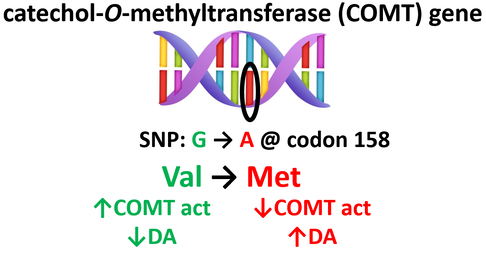
I will focus specifically on an interesting genetic variant in the COMT gene. What is COMT? It is an enzyme that helps to break down dopamine, as well as other chemicals with similar molecular structures, and regulate its level in the body and brain. A single nucleotide polymorphism (SNP) in the COMT gene (G->A DNA substitution resulting in a Val->Met amino acid variation in the protein; and denoted as the Val158Met COMT variant) results in a differential stability of the COMT enzyme, allowing it to more or less efficiently breakdown dopamine. And while COMT breaks down a variety of catecholamines, including norepinephrine, epinephrine, and dopamine, it plays a majority role in regulating dopamine levels in the PFC. Those with the COMT Val polymorphism have higher enzymatic activity and therefore lower levels of tonic PFC dopamine. In contrast, the COMT Met polymorphism results in lower COMT activity and therefore higher levels of tonic PFC dopamine.
Several studies (see comprehensive review here) have demonstrated that individuals with the Met version of the COMT enzyme perform well in cognitively demanding tasks but have an enhanced vulnerability to stress (worrier); they wilt under pressure.
In contrast, individuals with the Val version of COMT have better stress resiliency (warrior).
And it’s not just an effect on dopamine the Val158Met COMT polymorphism provides. Research has shown that ValVal individuals show lower physiological stress reactivity than MetMet individuals.
Taken together, these data suggest that individuals with two copies of the Met allele will generally perform poorer under stressful conditions than those with two copies of the Val allele while those with a copy of each allele will fall somewhere in between.
Should those individuals with the Met polymorphism in their COMT gene resign themselves to doing poorly on big standardized tests; wilting under pressure?
The short answer? No. The long answer? We are more than our genetics.
First, our genetics interact with other aspects of our biology to ultimately produce behavior. My own research has shown that COMT genotype interacts with age to affect Now vs Later decision making. We interpreted this in context of the inverted-U relationship between dopamine and PFC function as dopamine levels are known to decline with age. So, a particular genetic setup that leads to supra-optimal dopamine levels when one is young may result in more optimal levels as one ages and dopamine “falls” down the curve toward more optimal levels.
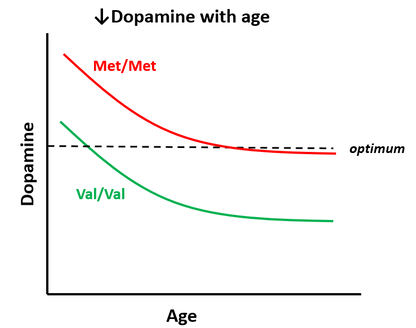
Biology is just one part of the equation.
Mindset, or how an individual reacts to the biological changes that accompany stress, is also critical.
It has been shown that taking a stress-is-enhancing mindset leads to better affective and cognitive outcomes than a stress-is-debilitating mindset.
COMT genetic variation has been shown to mediate the effect of a stress-is-enhancing mindset manipulation on affect and cognition such that those with two copies of the Met allele were more responsive to the manipulation than those with two copies of the Val allele. MetMet individuals can more easily develop a stress-is-enhancing mindset.
And while your COMT genetics may affect how well mindset manipulations work, anyone can take steps to re-frame their stressful experiences in such a way as to see stress as more of a benefit than a detriment. For example, treat your stress as something you learn from rather than dwelling on the negative aspects.
In closing, genetic variation in dopamine signaling plays a role in how we perform under cognitively demanding tasks. Evolutionarily speaking, it made sense for some people to perform well under pressure (Val warriors) while others performed better under baseline, unstressed conditions (Met worriers). We should embrace the genetic diversity inherent in this and other behaviors but also realize biology is only one determinant of behavior. Our mindset and how we frame the effect of stress on us is also critical and, in fact, has biological effects on our stress response.
The data presented here reflect a theme common in the brain and human behavior: behavior is modulated by both our biology and environment. Behavior is complicated and so to understand it, we need to look beyond merely our genes, proteins, and cells. Especially when it comes to human behavior, our environment and experiences affect our biology and behavior.
None of these relationships are simple, which is what makes studying them so interesting.
Catechol-O-Methyltransferase moderates effect of stress mindset on affect and cognition
Changing Stress Mindset Through Stressjam: A Virtual Reality Game Using Biofeedback
Quantitative role of COMT in dopamine clearance in the prefrontal cortex of freely moving mice
The influence of Val158Met COMT on physiological stress responsivity
COMT genetic variation affects fear processing: psychophysiological evidence
The efficacy of stress reappraisal interventions on stress responsivity: A meta-analysis and systematic review of existing evidence
Rethinking stress: the role of mindsets in determining the stress response
The catechol-O-methyltransferase Val(158)Met polymorphism modulates fronto-cortical dopamine turnover in early Parkinson's disease: a PET study
Site-Specific Role of Catechol-O-Methyltransferase in Dopamine Overflow within Prefrontal Cortex and Dorsal Striatum
Older age may offset genetic influence on affect: The COMT polymorphism and affective well-being across the life span
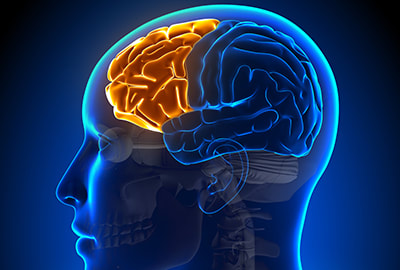
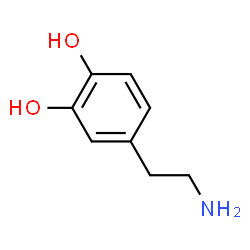

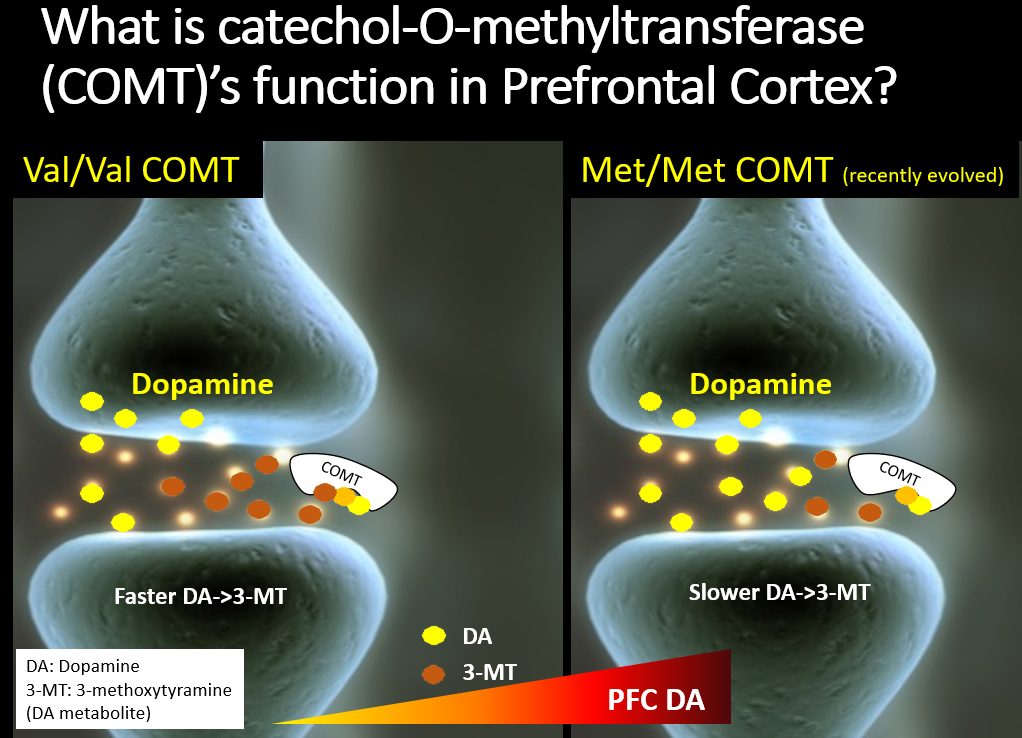
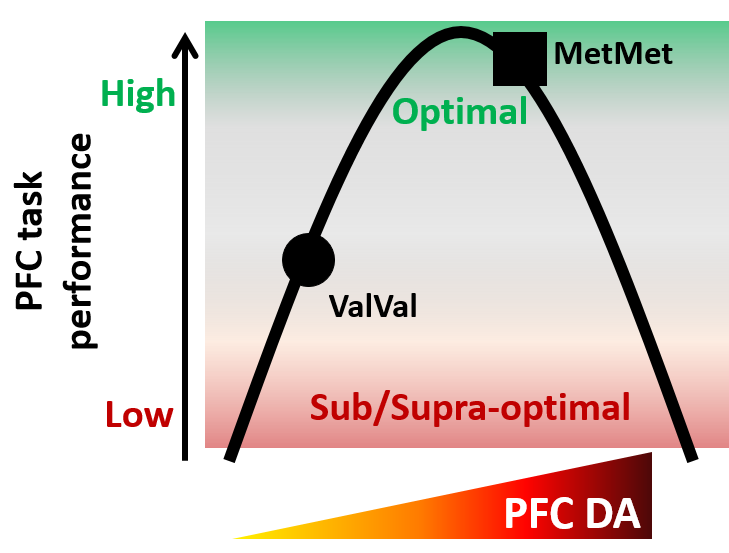

 RSS Feed
RSS Feed